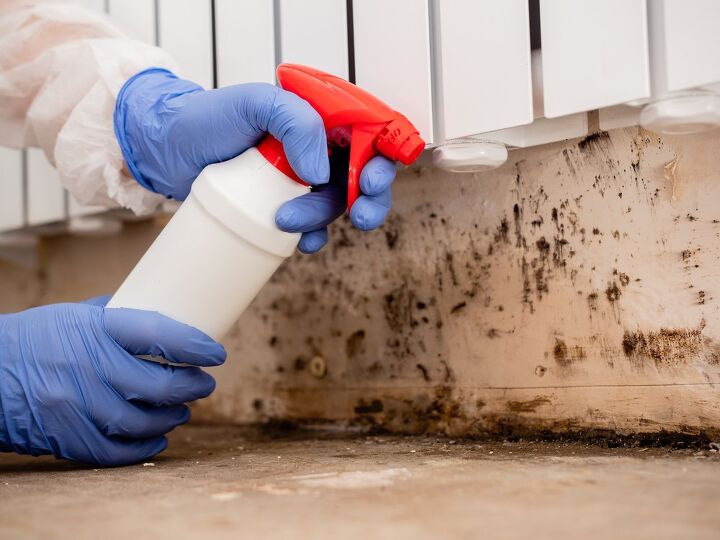Is Mold Under Flooring Dangerous?

Anyone, especially small children and the elderly should avoid living in a mold-infested home. Anyone who comes into contact with mold may develop a lung infection. The condition is triggered by an allergic reaction, which can result in short- or long-term reactions. Even a single person can die as a result of a strong response.
Mold under flooring or anywhere in your home is dangerous. According to the CDC, long-term mold exposure can be harmful to the human body. Mold can cause life-threatening consequences. Long-term effects can cause neurotoxicity and heart problems. It is important to hire a skilled expert to eradicate the mold under your flooring, as it may be in your drywall.
In this article, we will talk about mold under your flooring and how you can tell whether you have this problem or not. It’s a problem that’s sadly very common but also very dangerous. Let’s get started.
How Can You Tell If You Have Mold Under Your Floor?
There are a few methods to tell whether you have mold under your floor. We will go over each and every one below:
- Smell: Mold under your hardwood floor or tile can cause a musty odor to spread throughout your home. This is because the mold produces fumes that can be rather unpleasant. This odor has been characterized by many homeowners as earthy, filthy socks, and rotten wood.
- Water stains: Visible water stains are a dead giveaway that mold is lurking. Mildew is formed by liquids that sit for too long before being cleaned, resulting in a spongy texture on your floors as you walk over them.
- Look under the flooring: The most obvious way to tell if you have mold developing beneath your flooring is to carefully lift up the hardwood planks or tile that you suspect has mold underneath them. You can pull the planks yourself, or you can hire a local cleaner to come out and inspect them for you.
Signs of Mold Under Floors
Mold is tough because it can grow almost anywhere in the correct circumstances. Even though vinyl flooring is moisture-resistant, mold can grow at the margins where the floor meets the wall. It can also grow in between the gaps if liquids are allowed to stagnate and sit for lengthy periods of time before being cleaned.
Look for black growth emerging from the edges of the planks, as well as discoloration or bubbling of the material if you suspect mold under or around the floor. It’s preferable if you check for water stains or other symptoms of water damage on a regular basis, especially in high-humid locations like around the toilet or sinks in the kitchen or bathroom.
Is Mold Dangerous?
It’s a popular misperception that all strains of mold are deadly. The majority of mold isn’t harmful or dangerous. Mycotoxin is produced by several molds, giving them a poisonous impact.
Molds that are highly poisonous do exist. On the other hand, these mold types are infrequent, and even these specific mold types are mostly only dangerous to infants and the elderly.
However, mold allergies are relatively frequent; therefore, if you are highly allergic to molds, you may be in worse shape than someone who isn’t exposed to the uncommon hazardous mold strains. Meanwhile, someone with a weakened immune system who comes into touch with pathogenic mold could be in the same boat as someone with a severe mold allergy.
How Expensive Is Mold Removal?
Mold eradication can be done in a variety of methods. While doing it yourself may be less expensive, it is always better to hire specialists because they will get it right the first time, saving you the aggravation of numerous tries.
However, depending on the degree of the mold that needs to be removed, it might be pricey. The average cost is expected to be around $1500. However, prices range from $500 for a bathroom clean to approximately $2000 for a full basement clean.
Mold removal in an attic can cost up to $7000, including new insulation and repairs. For accurate quotes, contact your local mold removal pros.
Can You Clean Mold Yourself?
If you decide you want to remove the mold on your own, you can do this, but please know that you should take the necessary precautions. Below are a few items you will need:
- Gloves
- Goggles
- Overalls or long protective clothing
- Change of shoes
- Plastic sheeting
- Tape or nails and hammer
- Large garbage bags
- Box fan
- Two large buckets
- Spray bottle
- Borax
- Scrub brush or broom
- Disposable rags
- Dehumidifier
1. Remove Your Furniture
You need to get rid of any items that have come into contact with the mold. Rugs, toss pillows, and possibly some tiny side tables or cupboards are examples of such items. You should immediately remove these objects from your residence by sealing them in garbage bags in any way you can.
Items that can be easily replaced should be thrown away unless they are extremely valuable to you. Other items, such as your couch and chairs, should be left out in the sun until you’ve finished cleaning your home.
2. Isolate the Room
You must now isolate the room from the rest of your home. Put a sheet of plastic or a tarp over the entrance and secure it with duct tape or a hammer and nails.
Then, in the affected room, open a window and set your box fan in the window or prop the fan up at an angle oriented towards the open window.
3. Pull Up the Flooring
Begin preparing to remedy the afflicted area by gently removing the wall trimming and, depending on the kind of flooring, removing the flooring as gently as possible. For a variety of reasons, it is recommended that the entire room’s floor be removed.
If you’re convinced that the afflicted area isn’t too large, you can choose to remove that tiny section of flooring together with another 1 or 2 feet of flooring. Remove a little more flooring to ensure the mold is just developing in that tiny area, but be prepared to remove the entire floor if evidence of the mold spreading further is discovered.
4. Remove the Mold
It’s now time to begin the mold removal procedure. In a big bucket, combine 1 cup of borax with 1 gallon of water. You can put this solution in spray bottles for small areas or use it straight from the bucket for a larger area.
Swab the affected area with a brush or broom dipped in the solution. Allow 10 to 15 minutes for the mixture to rest. This will saturate the mold, weighing it down and preventing the release of spores while also allowing the borax to destroy it.
Scrub the mold with the brush or broom again before applying another layer of the fresh borax solution and leaving it to sit for another 10 to 15 minutes before cleaning it again.
The borax should have killed the mold by now, and the scrubbing should have removed it from the subflooring. Do the same thing with any affected hardwood boards or tiles.
5. Vacuum the Mold Particles
All of the dead mold particles should now be vacuumed out. If possible, use a HEPA vacuum. Using a vacuum helps catch any small mold particles that were not killed by the borax solution you created.
If you don’t have a HEPA vacuum or even a vacuum, you can mix extra borax solution and saturate the floor with it before wiping it down with disposable cloths. However, you should try to prevent oversaturating the subfloor because this can make it easier for mold to reappear after you replace your flooring.
After you’ve removed all the dead molds, lightly spray the subfloor with the borax solution and let it dry for 24 to 48 hours.
6. Replace Flooring
Replace the flooring and trim with new or clean pieces, and treat the items you removed earlier in the borax solution with the same techniques as the subfloor, including rewashing any fabrics to eliminate the extra borax after the drying process. Allow it to completely dry before returning it to its rightful place.
Why Does Mold Need to be Removed if it’s Under Your Floor?
Molds come in a variety of shapes and sizes, but some are toxic to humans. Mold endospores disperse rapidly in the air. Inhaling mold can be harmful to one’s health in the short and long term. Mold can cause everything from allergies to death.
Molds that grow indoors are usually dangerous. As we discussed above, the mold must be removed. It isn’t necessary to know whether they are harmful or produce poisons. You just need to have it removed, regardless.
Can Mold Grow Under Vinyl Planks?
Although vinyl plank flooring is considered to be waterproof, this does not rule out the possibility of liquids seeping through the cracks, grooves, or edges and becoming trapped beneath the planks, allowing mold to form. When mold grows, it’s usually because you’re near a tub or toilet, which is the ideal mold environment.

Heather is a passionate writer who loves anything DIY. Growing up, she learned everything from home repairs to design, and wants to share her tips with you. When she's not writing, she's usually hiking or searching for her next DIY project.
More by Heather Robbins





























